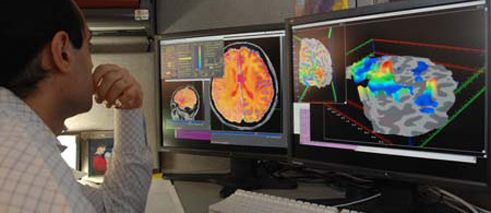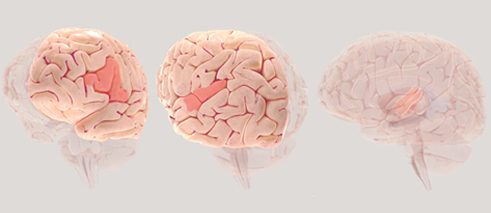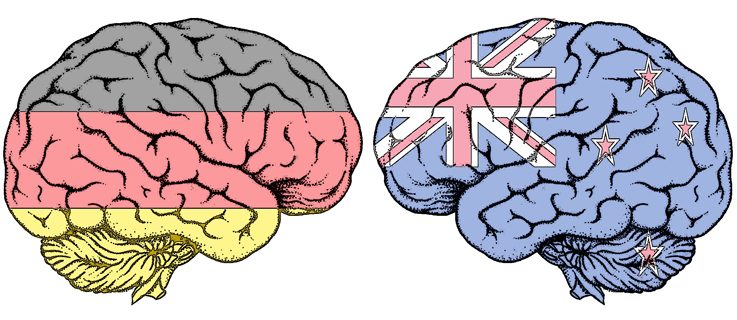Learning a new language is not only the path to new cultures, continents and people, it also has significant effects on the brain. Neuroscientist Kristina Wiebels explores the hidden benefits of thinking in more than one language.
Learning a new language is hard work. Hours and hours of learning new words, grammar, and spelling is not everyone’s idea of a relaxing evening at home. But the advantages are undeniable: learning foreign languages allows access to whole new worlds. But it also brings other benefits that are not immediately obvious. “Bilingual brains are more healthy,” says Ellen Bialystok, Distinguished Research Professor of Psychology at York University in Canada. Professor Bialystok and others have been studying the effects of bilingualism across the lifespan – how it moulds the minds of infants, how it affects cognitive abilities of adults, and how it influences brain changes during ageing. Using modern brain imaging techniques – including functional magnetic resonance imaging and electroencephalography – scientists are able to unlock secrets of the brain that usually remain hidden from us.
 © NIMH - US Department of Health and Human Services: National Institute of Mental Health
Researchers are tackling a variety of fascinating questions about the benefits of learning new languages. For example, in the bilingual brain, are both languages ‘”stored” and processed in the same regions of the brain or are they kept separate? What effects does bilingualism have on cognition? Is it confusing for children to grow up bilingually, or is it beneficial? And can speaking more than one language keep the brain fit during ageing? Even though there is still a lot to be explored, we now have answers to most of these questions.
© NIMH - US Department of Health and Human Services: National Institute of Mental Health
Researchers are tackling a variety of fascinating questions about the benefits of learning new languages. For example, in the bilingual brain, are both languages ‘”stored” and processed in the same regions of the brain or are they kept separate? What effects does bilingualism have on cognition? Is it confusing for children to grow up bilingually, or is it beneficial? And can speaking more than one language keep the brain fit during ageing? Even though there is still a lot to be explored, we now have answers to most of these questions.
Languages overlap and interact with each other in the brain
The language network in the brain consists of several regions mainly in the left hemisphere, each of which is specialised to process one particular aspect of language. This includes, for instance, speech production, speech comprehension, and processing of incoming speech signals. Experiments have shown that in the bilingual brain both languages are active at the same time, even when only one language is used in a specific context. This creates unique challenges for the brain. How does one keep track of which words are part of the language that is currently being spoken, and which ones have to be inhibited? Doing this requires extra work by the brain’s so-called executive functions. Just like the conductor of an orchestra coordinates musicians in order to keep the right tempo and harmoniously combine the different instruments, executive functions coordinate behaviours in order to focus attention and stay on task. Bilinguals use executive functions to a greater extent than monolinguals in addition to the typical language-related processes in order to resolve the competition between their languages. Executive functions act in this context like a traffic light, allowing one language to proceed, while stopping the other. This constant monitoring means that language is more effortful for bilinguals, which can lead to some costs in language processing, such as reduced speech fluency. But the benefits of bilingualism far outweigh these costs.
 © Society for Neuroscience (2017)
Language areas in the brain
© Society for Neuroscience (2017)
Language areas in the brain
Left: Broca’s area (speech
production), middle: Wernicke’s area (speech
comprehension), right: primary auditory
cortex (processing of incoming speech signals).
Bilingualism strengthens brain areas that underlie executive functions
The extensive use of executive functions is reflected in the brain activity of bilinguals: Brain regions in the prefrontal cortex of the brain that underlie these processes are activated in addition to the typical language network. This additional activation boosts the brain, which leads brain volume in these areas to increase and their function to strengthen. This in turn improves cognitive performance on tasks that rely on these functions. For instance, bilinguals have been shown to have enhanced performance at a variety of tasks that require inhibition, flexible switching between tasks, working memory, and task monitoring, all of which are executive functions and crucial for academic success, as well as predictors of long-term health and well-being. The extent to which these additional brain regions are recruited and therefore the magnitude of the associated benefits do not seem to depend on which languages are spoken, but instead on proficiency in the second language, overall fluency, frequency of use, and grammatical accuracy. Another important aspect is at which age the second language is acquired.
The brains of infants are extremely adaptable
The optimal time to learn a second language is very early in life. This is because the infant brain is very plastic, or malleable, and thus easily changes based on which cognitive functions are used the most. When growing up bilingually, the brain quickly adapts to the challenges of speaking two languages by shaping the brain’s networks and connections to deal with the increased monitoring demands. In contrast, the adult brain is relatively stable and needs more input or training in order for its structure or function to change. This property of the brain is the reason why it is so much easier to speak a language fluently when it is acquired at a very young age. This does not mean, however, that trying to learn a new language during adulthood is a lost cause. Brain changes and their associated cognitive benefits have also been observed in sequential bilinguals, who learned their second language during adulthood. It just takes a little bit more time and effort. But recent research suggests that this effort really pays off later on in life.
Learning new languages helps the brain stay fit
The cognitive benefits of speaking more than one language are usually quite subtle in healthy brains and might not be noticeable in everyday life. Effects are more dramatic when tasks are either really difficult, or when brain function is disrupted or deteriorating, as is the case for example in various types of dementia. Recent studies showed that bilingualism can delay symptom onset of Alzheimer’s disease by up to four years. Although bilinguals and monolinguals of the same age have on average the same amount of brain damage associated with the disease, bilingual brains are better able to cope. The theory behind this: bilingualism provides the brain with better compensatory mechanisms, as the brain is used to dealing with increased cognitive demands. But this is only the case if both languages are still mastered. Unfortunately, the almost forgotten school French does not help here. How exactly this boost in coping mechanisms comes about and whether these benefits are unique to bilingualism remains to be determined. But at the very least the process of learning a new language is a stimulating and challenging activity that helps the brain stay fit throughout life – in addition to the undeniable benefits of further understanding new cultures, including one’s own.
 © Steven Lewis on Unsplash
© Steven Lewis on Unsplash
